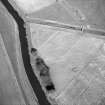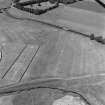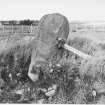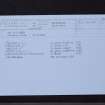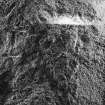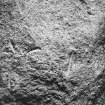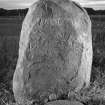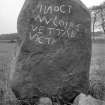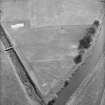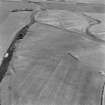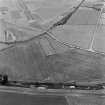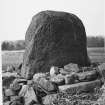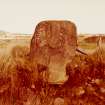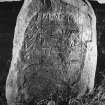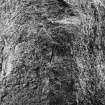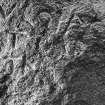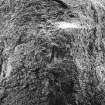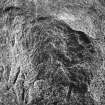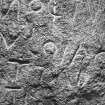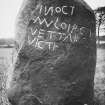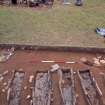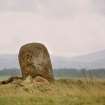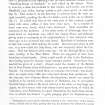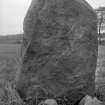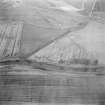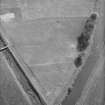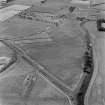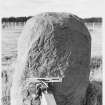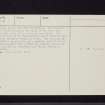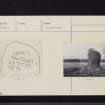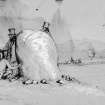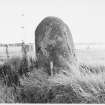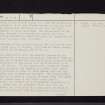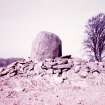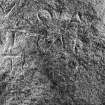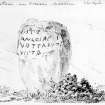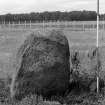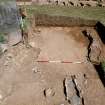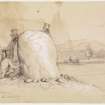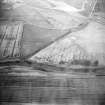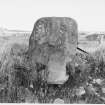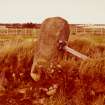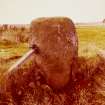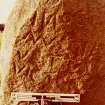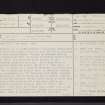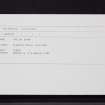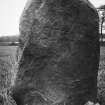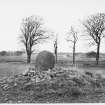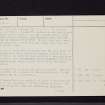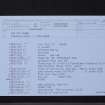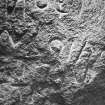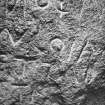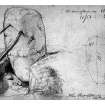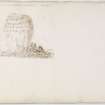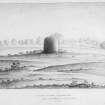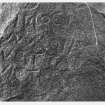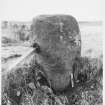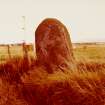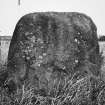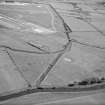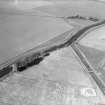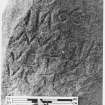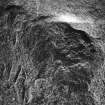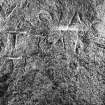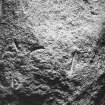The Cat Stane
Inscribed Stone (Period Unknown), Standing Stone (Prehistoric)
Site Name The Cat Stane
Classification Inscribed Stone (Period Unknown), Standing Stone (Prehistoric)
Alternative Name(s) Carlowie; Carlowrie; Catstane; Edinburgh Airport; River Almond
Canmore ID 50719
Site Number NT17SW 1
NGR NT 14893 74373
Datum OSGB36 - NGR
Permalink http://canmore.org.uk/site/50719
- Council Edinburgh, City Of
- Parish Kirkliston (City Of Edinburgh/midlothian)
- Former Region Lothian
- Former District City Of Edinburgh
- Former County Midlothian
In the middle of the first millennium AD the Catstane, a standing stone, acted as the focus for a cemetery of long-cist burials, and it is remarkable for the inscription it bears, which has been translated as 'In this tomb lies Vetta, daughter of Victricus' written in a script dated to the 5th or 6th century AD. It has been suggested that, originally, the stone formed part of a Bronze Age burial site, subsequently reused over two millennia later.
Information from RCAHMS (SC) 2 August 2007
Rutherford, A and Ritchie, JNG 1975
Catstane, Midlothian, inscribed standing stone
Measurements: H 2.0m +, W max girth 3.65m
Stone type: whinstone
Place of discovery: NT 1489 7437
Present location: on the north side of the main E-W runway of Edinburgh International Airport.
Evidence for discovery: first recorded in 1699 by Edward Llwyd and still in situ. The stone is thought to be a re-used Bronze Age standing stone. It became the focus for a large cemetery of burials in long cists.
Present condition:
Description
This rounded boulder bears on its east face an inscription in debased Latin capital letters, which reads ‘In this tomb lies Vetta, daughter of Victricius’.
Date: late fifth or early sixth century.
References: ECMS pt 3, 426-7; Rutherford & Ritchie 1974; Cowie 1978.
Compiled by A Ritchie 2016
NT17SW 1 14893 74373
(NT 1489 7437) Cat Stane (NR)
OS 1:10000 map (1974).
See also NT17SW 2 (long cist cemetery) and NT17SW 3.
The Catstane is a rounded boulder, irregularly trapezoidal in cross-section, with a girth at base of 3.65m, standing 1.3m above ground level. Judging by sketches made by James Drummond in 1860, it tapers in concave fashion below ground level, but it is not known whether it was deliberately shaped in this way. Its E face bears an inscription which now reads: IN OC T / MVLO IAC T / VETTA F / VICTR in a style of lettering suggestive of a late 5th or early 6th century date. A tentative reading of the inscription is, "In this tomb lies Vetta, daughter of Victricius".
Though there are now no surface remains apart from the Catstane itself, there can be no doubt that it stood on the perimeter of a low cairn with large horizontal kerbstones (seen by Lhwyd in 1699). The diameter of the cairn was "about seven yards" (6.4 m)) and the kerbstones "laid lengthwise, except one larger than ordinary, which is pitched on end" (the Catstane).
A drawing in the British Museum (Stowe MS 1023, f 19r, p.27) shows the Catstane on the perimeter of an oval of much smaller stones but there is the implication that those on one side are "laid lengthwise" as Lhwyd described. The measurements of the setting, however, are considerably larger than those originally recorded and below the cairn the dimensions are given as "14 paces long, 12 broad".
The presence of one upright stone on the line of the kerb of a small cairn is unusual, but it can be almost exactly paralleled at Cairnpapple (NS97SE 16).
Further information about the monolith depends on the interpretation of various excavations undertaken round it; Simpson and Hutchison did some small-scale digging in 1860 and found that it was buried to a depth of about 0.9m into the ground. "It was placed upon a basis of stones, forming apparently the remains of a built stone grave, which contained no bones or other relics, and that had evidently been searched and harried". The accompanying drawing and Drummond's original sketches throw some doubt on the precise form of the "built stone grave". Hutchison, who carried out more extensive excavations in 1864, states that the Catstane "stood over what was distinctly the side walls of a built grave identical in masonry and material" with the short cist found in the adjacent long cist cemetery (NT17SW 2). No skeletal remains were found. Drummond's sketches do not give a good impression of this feature, but one parallel for a rough slab-built setting within a standing-stone hole has been excavated at Orwell (NO10SW 8). On the other hand, what has been taken for a short cist may simply have been the bedding of the stone.
However, it is reasonable to assume that the long cists of the presumptively Early Christian cemetery follow in an area of Bronze Age activity represented by a standing stone and kerb-cairn of a recognisably second millenium BC type, the standing stone being re-used for an Early Christian inscription.
J Y Simpson 1863; R Hutchison 1868; D Wilson 1863; RCAHMS 1929, visited 1915; A Rutherford and J N G Ritchie 1975.
The 'Cat Stane' is as described and illustrated. Although falling within the extension to Edinburgh Airport, it has been fenced off for preservation.
Visited by OS (BS) 12 August 1974
Limited excavations were carried out prior to the proposed removal of the 'Catstane' from its present position. The area surrounding the stone was extensively disturbed, presumably during the 1860 excavations. An irregular trench around virtually the whole of the stone had removed all trace of the original stone-hole. The interpretation of the "stone-built grave" found at that time must therefore remain in doubt. The presence of two definite stone-holes and a probable third E of the Catstane suggests that prehistoric activity along the lines proposed by Rutherford and Ritchie remains a possibility.
T Cowie 1977.
Scheduled (with NT17SW 1) as 'Catstane, inscribed stone and long cist cemetery 690m E of Carlowrie...'
Information from Historic Scotland, scheduling document dated 22 July 2011.
Antiquarian Observation (1 September 1849)
Field Visit (13 April 1915)
Standing Stone, The ‘Cat Stane’.
The standing stone known as the ‘Cat (?’battle’-Gael. cath) Stane’ (Fig. 118 [SC1233406]), is erected on a slight ridge in a cultivated field some 80 yards from the right bank of the River Almond and about 370 yards north-north-west of Lennie Muir bridge on the Edinburgh and Linlithgow road, at an elevation of slightly over 100 feet above sea-level. It is an irregular, rounded boulder of whinstone, and measures 5 feet in height and 11 ¾ feet in girth at the base. On the eastern face near the top is a rudely cut Latin inscription of four lines with no spaces between the words:
IN OC T[VJMVLO JAC[ITJ VETTA F[ILIVSJ VICTI
"In this mound lies Vetta, son of Victus."
An examination made in 1861 revealed the fact that the stone stood over what were distinctly the side walls of a built grave (1).
In a description of this site contained in a letter written towards the end of the 17th century by Edward Lhwyd, a Welsh archaeologist, it is stated that there was ‘an area of about 7 yards in diameter encompassed with large stones; all which stones are laid lengthwise except one, larger than ordinary, which is pitched on end’ (2), the Cat Stane. In Wilson's Prehistoric Annals of Scotland (3) it is stated that a large tumulus which formerly stood about 60 yards to the west was opened in 1824 and found to contain several complete skeletons.
Immediately to the south-east of the stone fifty long cists and one short cist , laid east and west and containing human remains, were discovered in 1864 (4). The short cist was identical in character with the grave found beneath the stone.
RCAHMS 1929, visited 13 April 1915.
(1) Proc. Soc. Ant. Scot., vi. (1864-6), p. 187; (2) Ibid., vi, p. 189; (3) Vol. ii, p. 211; 4 Proc. Soc. Ant. Scot., vi, p. 185.
Aerial Photography (1966)
Oblique aerial photographs of the Cat Stane site, Midlothian, photographed by John Dewar in 1966.
Field Visit (12 August 1974)
The "Cat Stane" is as described and illustrated. Although falling within the extension to Edinburgh Airport, it has been fenced off for preservation.
Visited by OS (BS)
Excavation (1977)
Limited excavations were carried out prior to the proposed removal of the 'Catstane' from its present position.
T Cowie 1977.
Photographic Record (1979)
Test Pit Survey (April 2007)
NT 1489 7437 Test pitting was undertaken in April 2007 in the air-side grounds of Edinburgh Airport. The test pits were required in advance of a programme of Site Investigation (SI) works for the proposed Edinburgh Airport Rail Link. Seven test pits were required in the scheduled ancient monument known as Carlowie, Cat Stane, inscribed stone 640m E of (SAM No 1183). The stratigraphy varied in each test-pit. Some revealed
layers of made ground containing large quantities of shale waste, and modern glass, tile and ceramics, while others cut through sand or compact clays. Shale/blaes was present on the S side of the Cat Stane. Those on the N/NW side of the scheduled area, adjacent to the modern airport access road, had the deepest deposits. These results suggest that a considerable degree of ground disturbance and landscaping has taken place in the past, possibly associated with the former Dunnet Shale Workings or with the construction of the airport. All test pits were excavated to natural subsoil. No features or deposits of archaeological significance were recorded.
Archive to be deposited with RCAHMS. Reports to be deposited with CECAS and RCAHMS.
Funder: Tie Ltd.










































































